List of Authors
>>About this blog
Recent blog post
|
[Silver]
March 17, 2017 09:00
On a walk in Nihonbashi, walking along Muromachi Koji, thinking that it is a soba, a ladle, or a ladle today, is a new discovery.
A shop called "Sanki Udon Hoshino" was opened after 3 o'clock on Sunday.
If you try to enter "Try things", your child will come out after the meal.
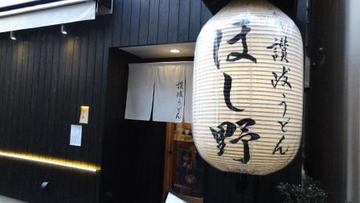
The catchphrase "It's not just a hard udon."
The first shop was "Do you have a waist in the noodles?" There is a question, "Is the topping Tenfura warm?"
Since it was after 3 o'clock, I was able to expand the map of Chuo-ku at the table seat, put out documents, and consider the guide course.
Wait for a while, warm  ton, freshly fried ton, freshly fried shrimp tempura, shrimp tempura,
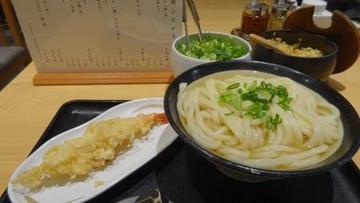
Squid Geso, the Tenfura of Maitake mushroom!
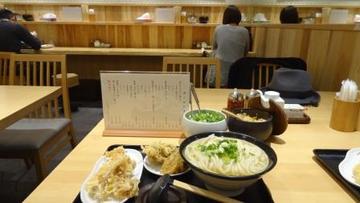
In Nihonbashi, freshly fried Tenfura and ladies. Try it when you are near you.
(I don't know if freshly fried Tenfura will appear during lunch crowded with office workers.)
[Silver]
March 16, 2017 14:00
The Chuo-ku Tourist Information Center opened in Kyobashi Edgran in November 2016, and it has been four months since it opened.
Today, I studied at "Chuo-ku Virtual Map OVERVIEW" installed at the Chuo-ku Tourist Information Center on the first basement floor.
Looking at the current location and old maps of the Edo period, what happened here in the past? I can study such things.
 The woman in charge was kind and taught me how to operate it. The woman in charge was kind and taught me how to operate it.
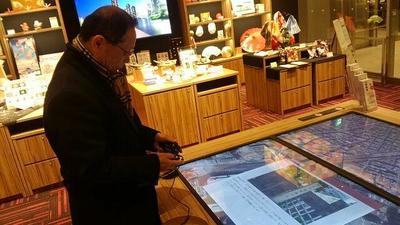
Using the steering wheel, I freely operated the map on the large screen and searched for tourist attractions as if I were walking in the air. I was able to see the streets of Nihonbashi Muromachi using "Kidai Shoran".
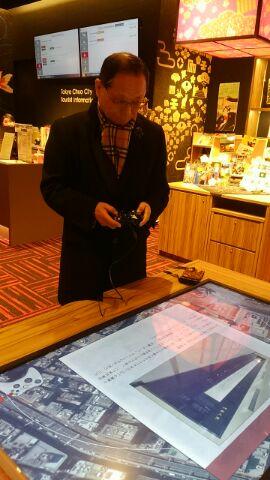
"I can do it!" "Please look at the picture of the evidence that you are operating happily."
During shopping and walking in Chuo-ku, please drop in and enjoy. It is also ideal for studying for children such as elementary school students.
In the Chuo-ku Tourist Information Center, you can get a map of not only Chuo-ku but also nearby, and you can also buy small items such as Chuo-ku original Tenugui. Please use it as a small souvenir.
[Silver]
March 15, 2017 18:00
In Tsukiji River Park next to St. Luke's International University, cherry blossoms are in full bloom on  the cherries that signal the coming of spring. Is the best time to see it until March 18? the cherries that signal the coming of spring. Is the best time to see it until March 18?

Nearby, there is a tree planting to commemorate the birth of a newborn baby.
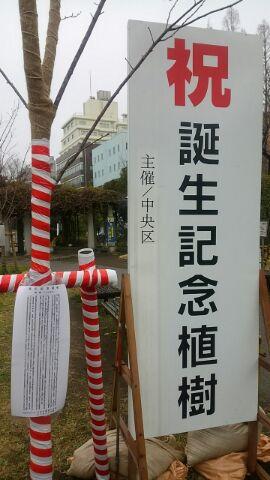
Congratulations on the birth of about 270 newborns in total.
We pray for the healthy growth of the children running around the park, new lives sprout, bright voices echo, and children running around the park.
[Silver]
March 13, 2017 16:00
The stone monument of "Hakuya Matsuo Momo Aojuku Spring" is built at the front of the current long-established Tsukudani shop "Nihonbashi Funasa" where the poet Matsuo Basho stayed.

This is the place where Matsuo Basho, 29 years old in 1672 (Kanbun 12), came from his hometown Iga Ueno to Edo for eight years.

Matsuo Basho lived in Odawaracho, a downtown area close to the Nihonbashi Fish Market, and solidified his position in the haiku altar, and became independent as a master of haikai in 1678. "Hakuya Matsuo Momo Aojuku Spring" in stone monument describes the spirit of Yingshu as a master during the New Year of the following year. Later, Matsuo Basho moved to Fukagawa, where he moved to Senju in preparation for his trip to narrow road to the interior in 1689 (Genroku 2), and 46-year-old Matsuo Basho went on a journey to narrow road to the interior.
A woman watching "Okame Sakura" planted on the pavement next to "Tokyo Square Garden" in Kyobashi suddenly called out and asked, "What kind of cherry tree is it?"
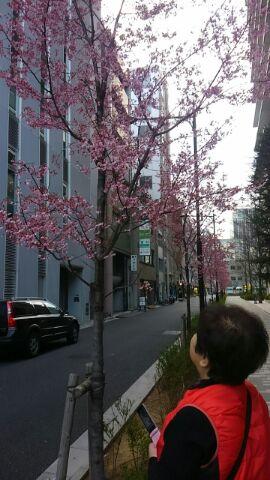
He told me, "It's a okame cherry tree" because "the red color is dark and the flowers are downward."
"Okame" here is named to mean beauty and charming.
The next day, Nihonbashi strolled along Muromachi Koji and enjoyed the "Okame Sakura" in full bloom.

The cherry blossoms around "Shigeru Kami" are a must-see. Please come early.
[Silver]
March 8, 2017 16:00
"Tsukiji TASS Gharari Wakamatsuya" is located at 6-12-3 Tsukiji, and the signboard construction of the copper plate is a landmark of the town.
Every year, we participate in the whole museum of Chuo-ku in autumn, and introduce the works of various artists.
This time, an exhibition of works by Michio Nakamura, a writer from Hinode-cho, Nishitama-gun, is being held. The period is from March 6th to 11th.
This is the process of creating the original picture. On the right side is a picture postcard.
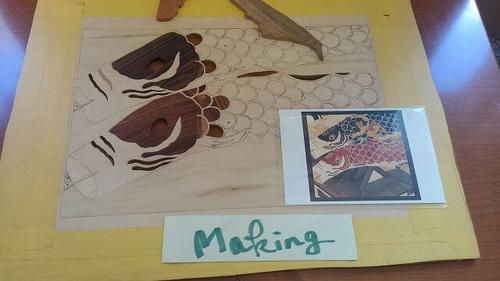
It is a work that was processed into a chair.
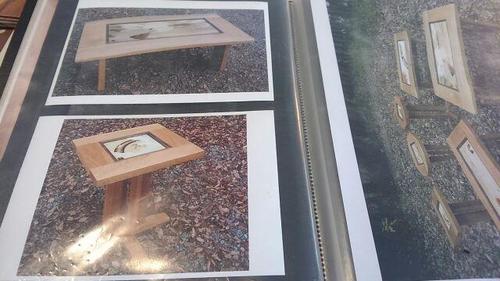
"Kumiki-e" is a picture created using dozens of kinds of trees. The "warmth" of the tree is transmitted and the mind calms down . .
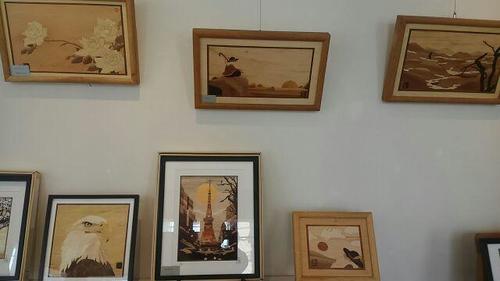
The works include the heart of the Japanese heart, Mount Fuji, Tokyo Tower, etc., and the heart is healed by watching. By all means, please drop in.
Address of "Tsukiji TASS Gharari Wakamatsuya": 6-12-3 Tsukiji, Chuo-ku, telephone: 03-3541-0124
[Silver]
March 7, 2017 18:00
The camellia planted in front of "Shiseido Parlour" in Ginza 8-chome is blooming beautifully.

There is an explanation monument about this camellia tree.
"Izumo camellia". Before this area became the 8-chome of Ginza, it was called "Izumo-cho". The large-scale town development by Tokugawa shogunate, which began in 1603 (1603), was carried out as a "help contract" for the daimyo of each country, and it is said that the name of the country of the people who contracted the plot and created it was related to the town name.
In order to beautifully collect Hanatsubaki-dori, we received a donation of eight Izumo Japanese camellia trees from Izumo City, which is related to the street, and planted them as street trees.
About 400 years after the town was born, 1993 (Heisei 5). This camellia symbolizes the historical depth of Ginza and Izumo, which have been revived in the town development of "Hanatsubaki Street". (Chuo-ku, Tokyo, March 8, 1993)
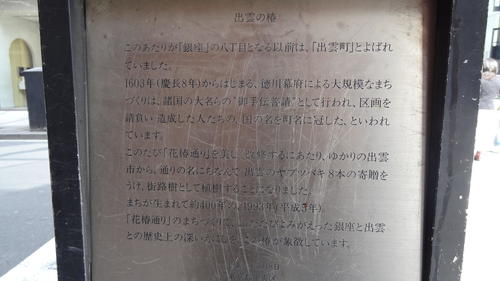
And camellia flowers came to be used in the company's products.
Well, it's about to be White D. Why don't you look for cookies and other items  in return for Valentine's Day? in return for Valentine's Day?
|
Links
|
![]() ton, freshly fried
ton, freshly fried![]() shrimp tempura,
shrimp tempura,
















